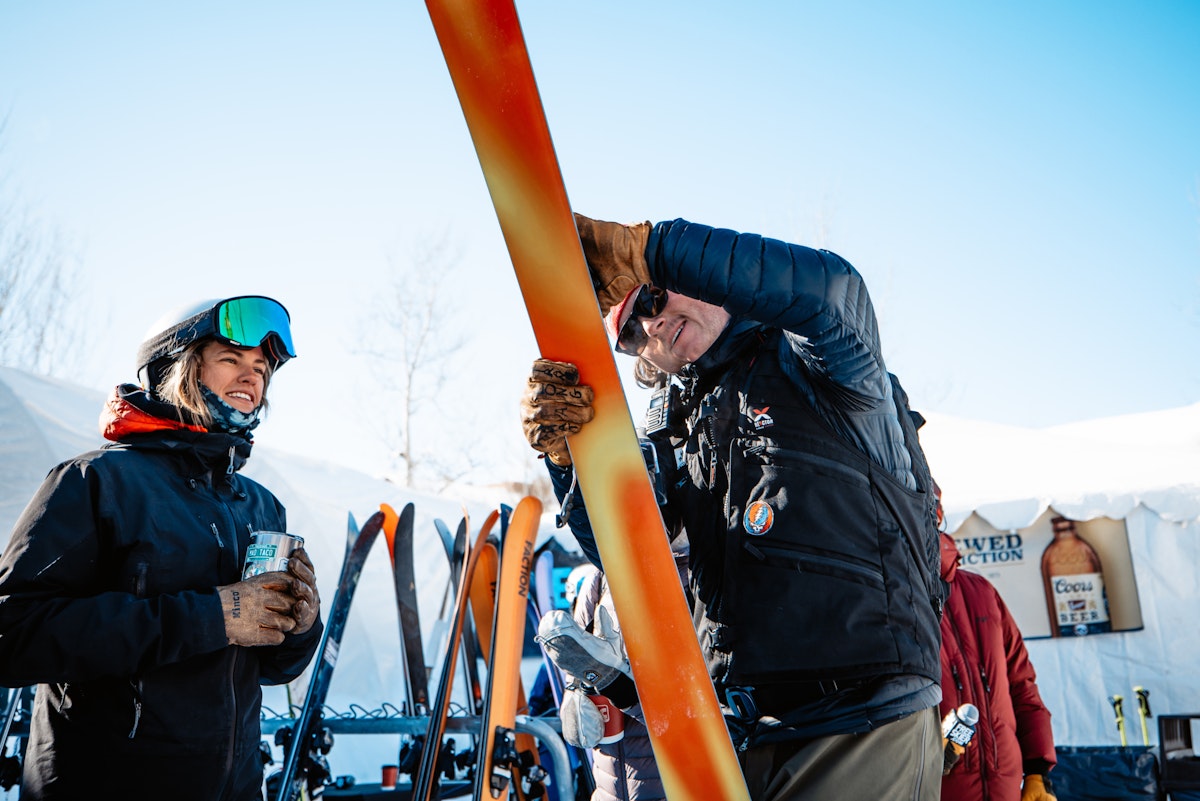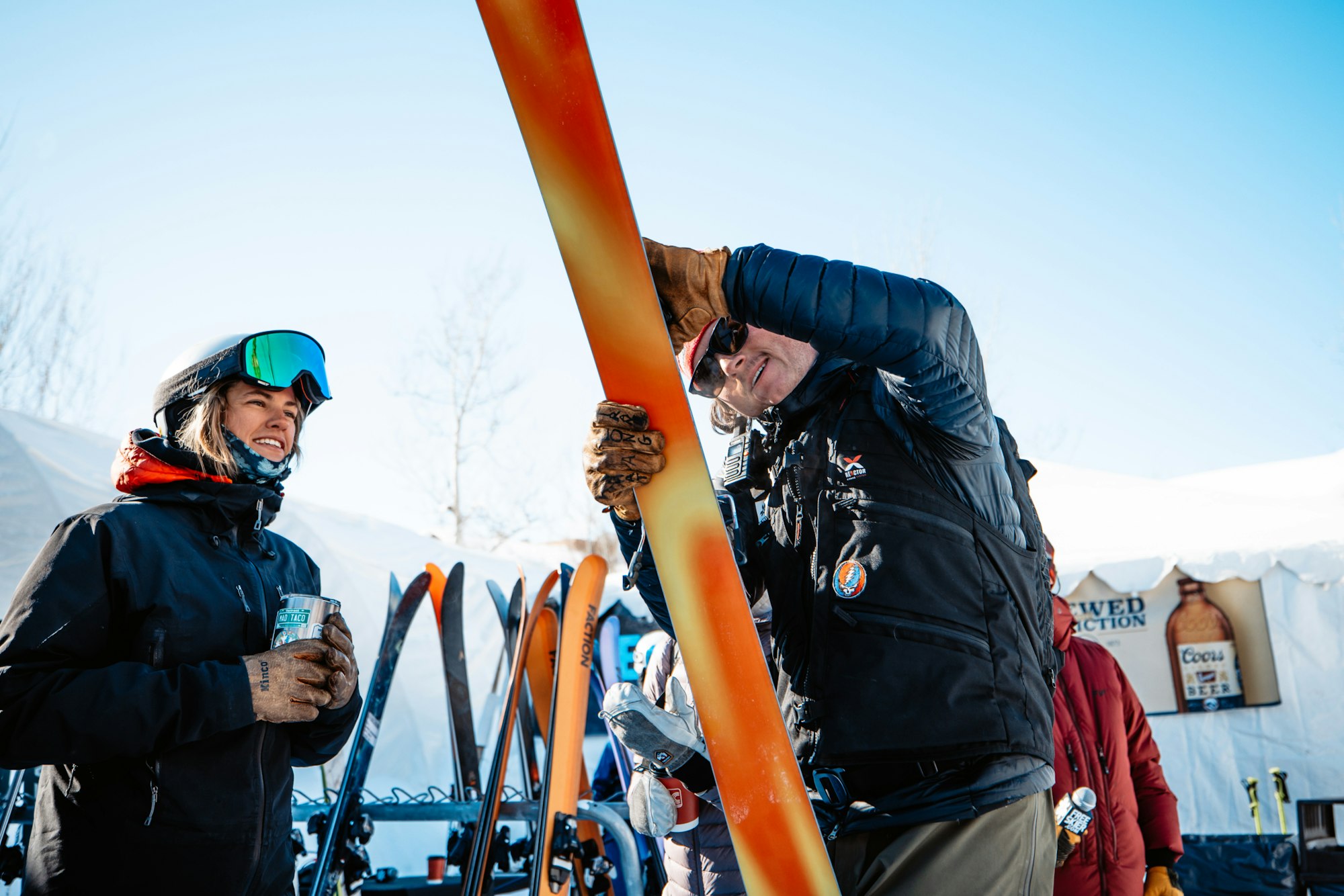Featured Image: Elise Sterck
Inspect Your Skis Now
This may seem rudimentary but how often do you inspect your gear? Like, really inspect it. Take some time to look closely at the top sheets, edges and bases of your skis. Look for any signs of delamination (separation between the materials), ensure your edges don’t have any cracks and that there’s no damage to the base that reveals the core material. If you catch small damage early enough, you can get it repaired at your local shop before it becomes a real headache and requires costlier repair or replacement.
Similarly, take a few minutes to look over your favorite outerwear. Check along the seams for delamination or torn stitching. Some of the premier brands such as Arc’teryx, Patagonia and Mountain Hardwear will repair these for free. If the brand won’t do it, you can also take it to a local shop that specializes in outdoor gear repair.
Store Your Gear Properly
“Why are my edges all rusty?” Well that’s probably because you left your wet skis sitting in your roof box for two weeks. At the end of the day, we know it’s tempting to just toss your gear aside and move on with your busy life but proper short- and long-term gear storage ensures your prized possessions are ready to go when you are. Take a few extra minutes at the end of each ski day to put your gear in a place where it can dry. Bring your skis inside, hang your skins up and lay your gloves by a heater before you melt into the couch. You’ll thank yourself when you’re not sliding into smelly, wet gear the next time you head out. When the season comes to an end (sad face), put a coat of protective wax on your skis, clean all your apparel and store everything in a cool and dry place.
Tune Your Skis Often
There’s hardly a more satisfying feeling than the smooth glide that comes with a fresh coat of wax, or laying into a turn on freshly sharpened edges. These are the benefits to a well-tuned pair of skis—but they’ll ultimately fade over time. As they do, so too does your cognizance of the lost performance. As the tune wears off, you unknowingly adapt to the decreased efficacy of your skis and forget that they would actually be far more fun if you gave them a bit of love.
At the very least, you should have your skis tuned before the season starts and then again midway through the winter. For those of you who are getting more time on snow, take the time to get your skis tuned monthly. If you’re a bit more technically inclined, DIY tuning isn’t all that hard with the proper equipment and many local shops host educational workshops to get you up to speed, allowing you to save time and money by waxing and sharpening your sticks over a beer with friends.


PHOTO: Elise Sterck
Clean Your Outerwear More
We wouldn’t say you’re out of line to put your apparel through the wringer as you slash your way down the mountain, or adorn it with the occasional beer or nacho stain, but we will chastise you for not cleaning it every now and then. It can be easy to forget that, much like your hardgoods, your jacket and pants are high-functioning pieces of equipment that need to stay clean in order to perform well. The waterproof and breathable layer underneath the face fabric has microscopic holes in it that allow the jacket to breathe (expel vapor) from within, keeping you dry and warm. When those holes get plugged with whatever it may be, they’re rendered useless.
So while you might wear that cheesy reminder of your last après session as a badge of honor, you hinder the performance of the technical membrane underneath it by doing so. To keep your outerwear in proper working condition, use a technical detergent like Nikwax’s Tech Wash or Down Wash.Direct to remove stains and get your apparel back to looking and performing its best. The Durable Water Repellent on the face fabric can also wear off after time and Nikwax’s Tx.Direct Wash-In can help you restore that.
Touch Your Goggles Less
Your goggles are your window to the winter world and there’s hardly a more common annoyance amongst skiers than scratched or foggy lenses. Nine out of 10 times, this can be attributed to user error, as skiers generally don’t understand what contributes to their lack of performance: warmth, moisture and poor handling. Fog is just moisture that has gotten into your goggles and condensed on or in between the lenses. This can happen a number of ways but the most common is that you’re overheating and then sweating into the face foam, or you had an epic crash into three feet of powder.
Believe it or not, the best way to combat foggy goggles is to properly layer your apparel for the temperature you’re skiing in, as well as the level of aerobic output your day involves. By keeping your temperature regulated, you’ll decrease sweating which will help keep your goggles dry and clear. Secondly, you should touch your goggles as little as humanly possible. The more you keep your grubby little hands away from them, the less oily residue will end up on them to further complicate the matter. Whenever possible, avoid putting goggles up on a beanie or helmet, both of which can be sweaty or snowy. If you go inside to take a break, take your goggles completely off and rest them in a place away from any food, drinks or things that can scratch the lenses. Better yet, bring them to the bathroom and put them under the hand dryer for a bit. To avoid scratching the lenses, wipe them only when completely necessary and only with a microfiber cloth or goggle case.
Whatever You do, Take Care of Your Shoes
As skiers, we have a love/hate relationship with our hard-plastic shoes. We love the performance but hate it when they don’t feel good. Thankfully, ski boots have come a long way over the years and with the proper care, you can bolster the comfort and lifespan of them, avoiding the expenditure and break-in period of a new pair.
As you put mileage on your boots via parking lots to ridge scrambles, it’s not uncommon for the sole of your boot to wear down. This can lead to a poor connection between your boot and binding. Luckily, many boots have replaceable sole pieces. These can be purchased from your local shop or directly from the brand and easily screwed into place. Inspect your soles and buckles regularly to ensure everything is in good working order.
Every time you get off the hill, bring your boots inside and make it a priority to get them warm and dry. Pulling the liners out is the best way to speed this process up. If you haven’t done it before, fully unbuckle the boot, hold the top of the rear cuff with one hand and pull the liner up and toward the toe of the boot with the other hand. Once the liners are out, be sure to re-buckle the boots to keep the shape of the shell intact and place the shells and liners close (but not too close!) to a heat source. With a bit of extra effort, you’ll never have to slide your foot into a soul-crushing wet liner again.


![[GIVEAWAY] Win a Head-to-Toe Ski Setup from IFSA](https://www.datocms-assets.com/163516/1765920344-ifsa.jpg?w=200&h=200&fit=crop)
![[GIVEAWAY] Win a Legendary Ski Trip with Icelantic's Road to the Rocks](https://www.datocms-assets.com/163516/1765233064-r2r26_freeskier_leaderboard1.jpg?w=200&h=200&fit=crop)


![[GIVEAWAY] Win a Legendary Ski Trip with Icelantic's Road to the Rocks](https://www.datocms-assets.com/163516/1765233064-r2r26_freeskier_leaderboard1.jpg?auto=format&w=400&h=300&fit=crop&crop=faces,entropy)




![[GIVEAWAY] Win a Head-to-Toe Ski Setup from IFSA](https://www.datocms-assets.com/163516/1765920344-ifsa.jpg?auto=format&w=400&h=300&fit=crop&crop=faces,entropy)


